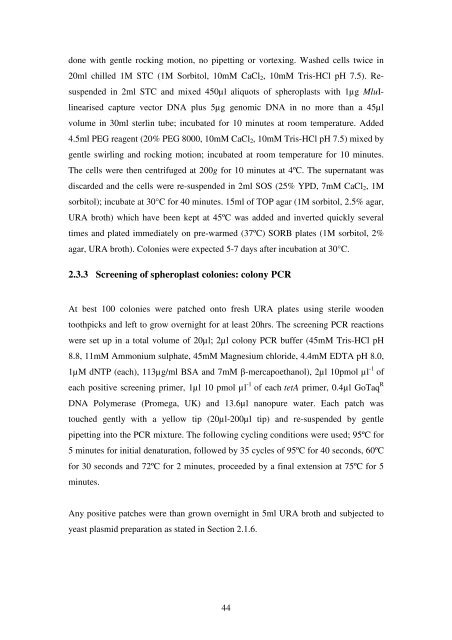5 The role of quorum-sensing in the virulence of Pseudomonas ...
5 The role of quorum-sensing in the virulence of Pseudomonas ...
5 The role of quorum-sensing in the virulence of Pseudomonas ...
You also want an ePaper? Increase the reach of your titles
YUMPU automatically turns print PDFs into web optimized ePapers that Google loves.
done with gentle rock<strong>in</strong>g motion, no pipett<strong>in</strong>g or vortex<strong>in</strong>g. Washed cells twice <strong>in</strong><br />
20ml chilled 1M STC (1M Sorbitol, 10mM CaCl2, 10mM Tris-HCl pH 7.5). Re-<br />
suspended <strong>in</strong> 2ml STC and mixed 450µl aliquots <strong>of</strong> spheroplasts with 1µg MluI-<br />
l<strong>in</strong>earised capture vector DNA plus 5µg genomic DNA <strong>in</strong> no more than a 45µl<br />
volume <strong>in</strong> 30ml sterl<strong>in</strong> tube; <strong>in</strong>cubated for 10 m<strong>in</strong>utes at room temperature. Added<br />
4.5ml PEG reagent (20% PEG 8000, 10mM CaCl2, 10mM Tris-HCl pH 7.5) mixed by<br />
gentle swirl<strong>in</strong>g and rock<strong>in</strong>g motion; <strong>in</strong>cubated at room temperature for 10 m<strong>in</strong>utes.<br />
<strong>The</strong> cells were <strong>the</strong>n centrifuged at 200g for 10 m<strong>in</strong>utes at 4ºC. <strong>The</strong> supernatant was<br />
discarded and <strong>the</strong> cells were re-suspended <strong>in</strong> 2ml SOS (25% YPD, 7mM CaCl2, 1M<br />
sorbitol); <strong>in</strong>cubate at 30°C for 40 m<strong>in</strong>utes. 15ml <strong>of</strong> TOP agar (1M sorbitol, 2.5% agar,<br />
URA broth) which have been kept at 45ºC was added and <strong>in</strong>verted quickly several<br />
times and plated immediately on pre-warmed (37ºC) SORB plates (1M sorbitol, 2%<br />
agar, URA broth). Colonies were expected 5-7 days after <strong>in</strong>cubation at 30°C.<br />
2.3.3 Screen<strong>in</strong>g <strong>of</strong> spheroplast colonies: colony PCR<br />
At best 100 colonies were patched onto fresh URA plates us<strong>in</strong>g sterile wooden<br />
toothpicks and left to grow overnight for at least 20hrs. <strong>The</strong> screen<strong>in</strong>g PCR reactions<br />
were set up <strong>in</strong> a total volume <strong>of</strong> 20µl; 2µl colony PCR buffer (45mM Tris-HCl pH<br />
8.8, 11mM Ammonium sulphate, 45mM Magnesium chloride, 4.4mM EDTA pH 8.0,<br />
1µM dNTP (each), 113µg/ml BSA and 7mM β-mercapoethanol), 2µl 10pmol µl -1 <strong>of</strong><br />
each positive screen<strong>in</strong>g primer, 1µl 10 pmol µl -1 <strong>of</strong> each tetA primer, 0.4µl GoTaq R<br />
DNA Polymerase (Promega, UK) and 13.6µl nanopure water. Each patch was<br />
touched gently with a yellow tip (20µl-200µl tip) and re-suspended by gentle<br />
pipett<strong>in</strong>g <strong>in</strong>to <strong>the</strong> PCR mixture. <strong>The</strong> follow<strong>in</strong>g cycl<strong>in</strong>g conditions were used; 95ºC for<br />
5 m<strong>in</strong>utes for <strong>in</strong>itial denaturation, followed by 35 cycles <strong>of</strong> 95ºC for 40 seconds, 60ºC<br />
for 30 seconds and 72ºC for 2 m<strong>in</strong>utes, proceeded by a f<strong>in</strong>al extension at 75ºC for 5<br />
m<strong>in</strong>utes.<br />
Any positive patches were than grown overnight <strong>in</strong> 5ml URA broth and subjected to<br />
yeast plasmid preparation as stated <strong>in</strong> Section 2.1.6.<br />
44














